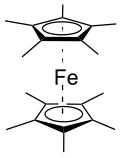Decamethylferrocene
 | |
| Names | |
|---|---|
| IUPAC name
Bis(η5 pentamethylcyclopentadienyl)iron(II) | |
| Other names
Decamethyl-ferrocene; 1,1',2,2',3,3',4,4',5,5'-Decamethyl-ferrocene; Bis(pentamethylcyclopentadienyl)iron(II); Permethylferrocene | |
| Identifiers | |
3D model (JSmol) |
|
| ChemSpider | |
| ECHA InfoCard | 100.116.086 |
PubChem CID |
|
| |
| |
| Properties | |
| C20H30Fe | |
| Molar mass | 326.31 g·mol−1 |
| Appearance | Yellow crystalline solid[1] |
| Melting point | 291 to 295 °C (556 to 563 °F; 564 to 568 K)[1] |
| 413 K, 5.3 Pa[2] | |
Except where otherwise noted, data are given for materials in their standard state (at 25 °C [77 °F], 100 kPa). | |
| Infobox references | |
Decamethylferrocene is a sandwich compound. In terms of structure and bonding it resembles ferrocene, but with a methyl group on each of the carbons of the cyclopentadienyl (Cp) rings. It is a yellow crystalline solid that is a weak reductant.
Preparation
Decamethylferrocene is prepared in the same manner as ferrocene from pentamethylcyclopentadiene. This method can be used to produce other decamethylcyclopentadienyl sandwich compounds.[1]
- 2 Li(C5Me5) + FeCl2 → Fe(C5Me5)2 + 2 LiCl
The product can be purified by sublimation. FeCp2* has staggered Cp* rings. The average distance between iron and each carbon is approximately 2.050 Å. This structure has been confirmed by X-ray crystallography.[3]
Redox reactions
Like ferrocene, decamethylferrocene forms a stable cation because Fe(II) is easily oxidized to Fe(III). Because of the electron donating methyl groups on the Cp* groups, decamethylferrocene is more reducing than is ferrocene. In a solution of MeCN the reduction potential for the [FeCp2*]+/0 couple is -0.59 V compared to a [FeCp2]0/+ reference (-0.48 V vs Fc/Fc+ in CH2Cl2).[2] Oxygen is reduced to hydrogen peroxide by decamethylferrocene in acidic solution.[4]
Using powerful oxidants (e.g. SbF5 or AsF5 in SO2, or XeF+ Sb2F11− in HF/SbF5) decamethylferrocene is oxidized to a stable dication. In the Sb2F11− salt, the Cp* rings are parallel. In contrast, a tilt angle of 17° between the Cp* rings is observed in the crystal structure of the SbF6− salt.[5]
References
- 1 2 3 King, R. B.; M. B. Bisnette (1967). "Organometallic Chemistry of the Transition Metals XXI. Some π-pentamethylcyclopentadienyl Derivatives of Various Transition Metals". J. Organomet. Chem. 8 (2): 287–297. doi:10.1016/S0022-328X(00)91042-8.
- 1 2 Connelly, N.; W.E. Geiger (1996). "Chemical Redox Agents for Organometallic Chemistry". Chem. Rev. 96: 877–910. doi:10.1021/cr940053x. PMID 11848774.
- ↑ Freyberg, D. J; L. Robbins; K.N. Raymond & J.C. Smart (1979). "Crystal and molecular structures of decamethylmanganocene and decamethylferrocene. Static Jahn-Teller distortion in a metallocene". J. Am. Chem. Soc. 101 (4): 892–897. doi:10.1021/ja00498a017.
- ↑ Su, B.; Hatay, I.; Ge, P. Y.; Mendez, M.; Corminboeuf, C.; Samec, Z.; Ersoz, M. and Girault, H. H., "Oxygen and proton reduction by decamethylferrocene in non-aqueous acidic media", Chem. Commun., 2010, volume 46, 2918-2919. doi:10.1039/B926963K
- ↑ Malischewski, M.; Adelhardt, M.; Sutter, J.; Meyer, K.; Seppelt, K. (2016-08-12). "Isolation and structural and electronic characterization of salts of the decamethylferrocene dication". Science. 353 (6300): 678–682. doi:10.1126/science.aaf6362. ISSN 0036-8075. PMID 27516596.